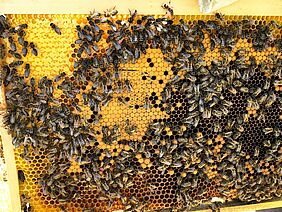(Frick, 5 April 2022), Honeybees that are aggressive are unpleasant for beekeepers. In traditional beekeeping in Switzerland, colony aggression is therefore considered a negative trait. One of the traditional breeding aims is a docile, easy-to-handle bee. This is also true for the European dark bee (see below). But gentleness as a breeding objective is now being called into question by the results of a four-year FiBL project funded by Aldi Suisse. "For us it was exciting to be able to support this project over several years in a superb cooperation with FiBL, and thus to be able to support scientific work," says Jérôme Meyer, National Executive of Aldi Suisse.
The analyses of 78 honeybee colonies of different generations at altitudes of 400 and 1500 m above sea level respectively has shown that gentleness as a breeding objective may come at the expense of the bees’ vitality and resilience. However, low-input and ethologically sound beekeeping (see below) strives for vital colonies that rely little on human management. "The project shows that in low-input, beecentric beekeeping a certain level of aggression may need to be tolerated," says Salvador Garibay, FiBL's project leader. "It is interesting to see that the bees become more vigorous and more able to survive when they regain some of their primordial traits."
Consistent selection for health parameters: the project
In the project, young colonies were selected for further breeding in the spring of 2020 and 2021. The exclusive selection criteria were as follows:
- Health: free from disease, moderate varroa infestation, healthy brood
- Vitality: activity, comb building, compact brood nest
- Resilience: nectar collection, pollen collection, food reserves
There was a tendency for more aggressive honeybee colonies to exhibit greater colony strength after overwintering. Therefore, the colonies selected for further breeding were predominantly those that had shown greater aggressiveness and good hygienic behaviour (removal of dead and diseased larvae) in the year prior, both being traits that appear to be influenced by the parent colonies’ temperament. At one of the sites it was investigated how many young colonies per parent colony had been selected for further breeding over the years and what had characterised these parent colonies. Here, too, it was found that primarily the more aggressive colonies had been used for propagation.
The European dark bee - an ancient native race
The European dark bee Apis mellifera mellifera has adapted to local conditions over millennia. It is the only honeybee species originally native to the regions north of the Swiss Alps and to northern and eastern Europe and it is one of the ProSpecieRara breeds. Its dark colouration and good cold tolerance are distinctive. The European dark bee can overwinter well even in harsh climates and produces a balanced honey yield. It has strong flight capabilities even at low temperatures. Moreover, the European dark bee temporarily pauses brood rearing not only in winter, but also when there is a dearth of nectar and pollen. This makes it more difficult for the dreaded Varroa mites to develop.
Low-input, beecentric beekeeping
Low-input beekeeping interferes as little as possible with the natural rhythm of life of a honeybee colony. Reproduction takes place naturally through swarming. The virgin queens are reared by their colony and freely mate on their nuptial flight(s). This is in contrast to the standard breeding techniques involving artificial queen breeding and controlled mating. Moreover, in low-input beekeeping, the bees are not given sheets of foundation with a regulated cell size. Instead they draw out their own comb in the frames provided (natural comb building). They are also only fed when forage conditions are poor or in preparation for winter. Low-input beekeeping does not use stimulant feeding to stimulate brood rearing.
Further information
FiBL contacts
- Ariane Maeschli
- Salvador Garibay
- Seraina Siragna
Funders and patrons
Aldi Suisse
Partner
imkerei-friedmann.de: Günter Friedmann, Demeter beekeper
Links
- fibl.org: Project "Conservation of dark bees by means of low-input beecentric organic beekeeping"
- orgprints.org: Article "Bienengerechte Zucht für die extensive Bioimkerei" (Beecentric breeding for low-input organic beekeeping; German only) by Ariane Maeschli, Salvador Garibay and Günter Friedmann in the Bioactualities magazine
Download
- Media release (612.0 KB)
- Media release (890.0 KB)
- Images





